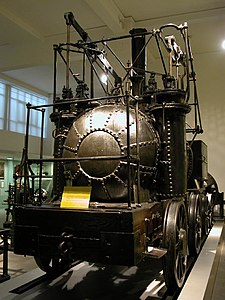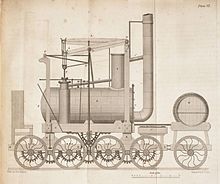For the heritage railway in Melbourne, Australia, see Puffing Billy Railway.
| Puffing Billy | |||||||||||||||||||||
|---|---|---|---|---|---|---|---|---|---|---|---|---|---|---|---|---|---|---|---|---|---|
 Puffing Billy as seen from the front Puffing Billy as seen from the front | |||||||||||||||||||||
| |||||||||||||||||||||
| |||||||||||||||||||||
| |||||||||||||||||||||
| |||||||||||||||||||||
Puffing Billy is the world's oldest surviving steam locomotive, constructed in 1813–1814 by colliery viewer William Hedley, enginewright Jonathan Forster and blacksmith Timothy Hackworth for Christopher Blackett, the owner of Wylam Colliery near Newcastle upon Tyne, in the United Kingdom. It was employed to haul coal chaldron wagons from the mine at Wylam to the docks at Lemington in Northumberland.
History
Precursors
The first steam-powered locomotive on rails was built by Richard Trevithick in either 1802 or 1804. He built several locomotives, and although the success of his 1802 locomotive at Coalbrookdale is questioned, his 1804 locomotive ran near the Pen-y-Darren Ironworks in Merthyr Tydfil, South Wales successfully enough to haul five wagons of iron for nine miles, winning a wager. Its excessive weight cracked the iron rails, rendering it impractical, and steam locomotives were not adopted at the time.
In 1810, the Durham Coalfield was disrupted by a major strike over the Bond system. During this time Christopher Blackett, owner of the Wylam Colliery, took advantage of the pit's idleness to experiment with the idea of a locomotive-hauled tramway worked purely by adhesion, rather than the Blenkinsop rack system that would be used on the Middleton. These began with a simple hand-cranked wagon, converted from a coal wagon chassis with the addition of a central drive shaft and geared drives to the axles.
As this experiment was successful, by 1812 it was followed by Wylam's first prototype 'travelling engine', worked by steam. This was based on a combination of the test wagon, with a single cylinder engine and boiler atop it. Little is known of the design, although it has been said to have been inspired by Trevithick's Pen-y-darren locomotive. It is unclear whether the single cylinder was vertical or horizontal, and whether the boiler had a single straight flue or a return flue. It may have been nicknamed Grasshopper. The 'travelling engine' was successful as a prototype, but underpowered and prone to stalling when overloaded or faced by a gradient. It was however convincing enough as a demonstration to encourage Blackett to fund further locomotives.
Prototypes
Puffing Billy was one of three similar engines built by Hedley, the resident engineer at Wylam Colliery, to replace the horses used as motive power on the tramway. In 1813, Hedley built for Blackett's colliery business on the Wylam Colliery line the prototypes, Puffing Billy and Wylam Dilly. They were both rebuilt in 1815 with ten wheels, but were returned to their original condition in 1830 when the railway was relaid with stronger rails.
In the September 1814 edition of Annals of Philosophy two locomotives with rack wheels are mentioned (probably Salamanca and Blücher), then there is mention of "another steam locomotive at Newcastle, employed for a similar purpose , and moving along without any rack wheel, simply by its friction against the rail road". From the context, this is at a different location to Blücher, so is probably Puffing Billy.
Puffing Billy remained in service until 1862, when Edward Blackett, the owner of Wylam Colliery, lent it to the Patent Office Museum in South Kensington, London (later the Science Museum). He later sold it to the museum for £200. It is still on display there. Its sister locomotive, Wylam Dilly, is preserved in the National Museum of Scotland in Edinburgh.
Two replicas exist: one, built in a Royal Bavarian State Railways workshop in 1906, is at the German Museum, Munich; the other, at Beamish Museum, was first run in 2006.
Design
Puffing Billy incorporated a number of novel features, patented by Hedley, which were to prove important to the development of locomotives. It had two vertical cylinders, one on either side of the boiler, and partly enclosed by it, and drove a single crankshaft beneath the frames, from which gears drove and also coupled the wheels allowing better traction.



The engine had a number of serious technical limitations. Running on cast-iron wagonway plates, its eight-ton weight was too heavy and broke them, encouraging opponents of locomotive traction to criticise the innovation. This problem was alleviated by redesigning the engine with four axles so that the weight was spread more evenly. The engine was eventually rebuilt as a four-wheeler when improved edge rails track was introduced around 1830. It was not particularly fast, being capable of no more than 5 mph (8 km/h).
Legacy
Puffing Billy was an important influence on George Stephenson, who lived locally, and its success was a key factor in promoting the use of steam locomotives by other collieries in north-eastern England.
It has been suggested that Puffing Billy's name survives in the English language in the intensifier like billy-o, but there are several alternative explanations for that phrase's origin.
References
- "Puffing Billy becomes world's oldest surviving locomotive". The Railway Magazine. 154 (1, 292): 9. December 2008.
- "'Puffing Billy' locomotive | Science Museum Group Collection". collection.sciencemuseumgroup.org.uk. Retrieved 26 May 2021.
- "Puffing Billy". Co-Curate - Newcastle University. Retrieved 1 June 2023.
- "Richard Trevithick introduces his "Puffing Devil"". A&E Television Networks. 13 November 2009. Retrieved 22 May 2023.
- Tann, Jennifer (23 September 2004). "Trevithick's locomotive of 1804 and the development of steam technology". Oxford Dictionary of National Biography (online ed.). Oxford University Press. doi:10.1093/ref:odnb/92727. Retrieved 22 May 2023. (Subscription or UK public library membership required.)
- "Lest we Forget – The Miners' Bond". Durham Records Online.
- Sidney Webb (1921). The Story of the Durham Miners. The Labour Publishing Company. p. 12.
- Smith (2015), pp. 21–23.
- Smith (2015), p. 25.
- Smith (2015), pp. 26–28.
- Casserley, H.C. (1976). Preserved locomotives (4th ed.). London: Ian Allan. pp. 13–4. ISBN 071100725X.
- Thomson, Thomas, ed. (1814), Annals of Philosophy, vol. IV, Robert Baldwin, p. 232, retrieved 16 December 2014
- Science Museum (1958). The British railway locomotive 1803–1850. London: Science Museum. p. 11.
- Martin, Gary (2018). "Like billy-o". The Phrase Finder. Retrieved 15 July 2018.
Sources
- Smith, George Turner (2015). Thomas Hackworth: Locomotive Engineer. Fonthill. pp. 26–32. ISBN 978-1-78155-464-7.
Further reading
- Kirtley, Allan, Longbottom, Patricia, Blackett, Martin (2013). A History of the Blacketts. (2013) The Blacketts. ISBN 978-0-9575675-0-4. Archived from the original on 23 June 2014.
{{cite book}}: CS1 maint: multiple names: authors list (link)
- Bailey, Michael R. (2014). "2: The First Industrial Locomotives: 1812–1815". Loco Motion. The History Press. pp. 23–30. ISBN 978-0-7524-9101-1.
| Pre-1830 steam locomotives | |
|---|---|
| Road |
|
| Railway |
|
| Designers | |